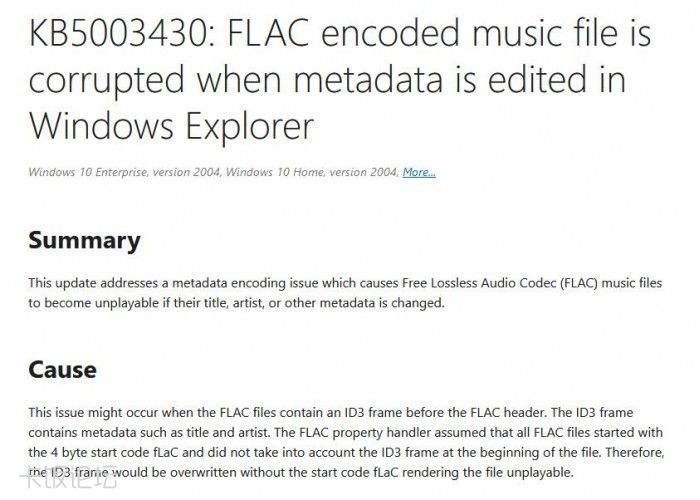如果你习惯从在线商城下载 FLAC(自由无损音频压缩编码)格式的音频文件,请不要使用 Windows 10 系统的资源管理器来编辑元数据。在 Windows 10 Version 2004 及更高版本中存在一个错误,如果使用资源管理器修改元数据,就有可能会损坏 FLAC 音频文件。

这个 BUG 影响 Windows 10 专业版、家庭版、企业版、工作站和其他 SKU 版本。根据本月早些时候发布的支持文件,Windows 10的文件资源管理器的错误将破坏某些FLAC文件,这些文件在FLAC头之前包含一个ID3框架。ID3是一个框架,它负责存储信息,如音乐标题、艺术家、专辑、曲目编号等。
在 Windows 10 系统,FLAC处理程序忽略了ID3框架,因为它认为FLAC文件在开头使用4字节的fLaC。当音乐文件被用户编辑时,ID3 框架被覆盖了,没有开始代码。因此,音乐播放器无法识别修改后的文件。如果音乐文件的标题、艺术家或其他元数据在文件资源管理器中被改变,音乐文件就不会播放或加载。
幸运的是,微软已经确定了根本原因,现在可以通过Windows Update进行修复。在 KB5003214 更新的更新日志中,微软确认该错误已被修复,如果你改变了他们的标题、艺术家或其他元数据,自由无损音频编解码器(FLAC)音乐文件将不再变得无法播放。
对于那些有损坏的音乐文件,微软已经发布了一个新的PowerShell脚本,你可以运行它来使文件再次播放。然而,它不能恢复存储在ID3框架中的丢失的元数据。为了避免FLAC音乐文件在未来出现问题,微软建议应用本月的可选累积更新。
解决方案
1. 打开记事本
2. 将以下脚本代码复制到记事本中
# Copyright 2021 Microsoft
# This script will repair a FLAC file that has been corrupted by Media Foundation in reference to KB5003430.
# Refer to KB5003430 for further information
param(
[parameter(Mandatory =$ true,
HelpMessage = "The path to the FLAC file that has been corrupted by Media Foundation",
ValueFromRemainingArguments =$ true)]
[ValidateScript({ -not [String]::IsNullOrEmpty( $_) -and (Test-Path $_) })]
[String] $ File
)
# We need to back up the current file incase we have any errors
$ FileDirectory = Split-Path -Resolve $ File
$ Filename = Split-Path -Leaf -Resolve $ File
$ FullPath = Join-Path -Resolve $ FileDirectory $ Filename
$ Filename = [String]::Format("Backup_{0:yyyyMMdd_hhmmss}_{1}", [DateTime]::Now, $ Filename)
$ BackupLocation = Join-Path $ FileDirectory $ Filename
Write-Output "Microsoft FLAC Repair Tool. This tool will repair a FLAC audio file that was corrupted when editing its details."
Write-Output "Affected File: $ FullPath"
Write-Output "A backup of the file will be made: $ BackupLocation"
Write-Output "Do you wish to continue?"
$ choice =$ host.ui.PromptForChoice("Fixing FLAC Script", "Do you wish to continue", ('&Yes', '&No'), 1)
function ParseStreamInfoMetADATABlock([System.IO.FileStream] $ stream)
{
$ blockType = $ stream.ReadByte()
$ lastBlock = ($ blockType -shr 7) -ne 0
$ blockType = $ blockType -band 0x7F
if ($ blockType -ne 0)
{
return $ false
}
$ blockSize = (($ stream.ReadByte() -shl 16) -bor ($ stream.ReadByte() -shl 8) -bor $ stream.ReadByte())
if ($ blockSize -lt 34)
{
return $ false
}
$ minAudioBlockSize = ($ stream.ReadByte() -shl 8) -bor $ stream.ReadByte()
$ maxAudioBlockSize = ($ stream.ReadByte() -shl 8) -bor $ stream.ReadByte()
if ($ minAudioBlockSize -lt 16 -or $ maxAudioBlockSize -lt 16)
{
return $ false
}
$ minFrameSize = (($ stream.ReadByte() -shl 16) -bor ($ stream.ReadByte() -shl 8) -bor $ stream.ReadByte())
$ maxFrameSize = (($ stream.ReadByte() -shl 16) -bor ($ stream.ReadByte() -shl 8) -bor $ stream.ReadByte())
$ sampleInfo = (($ stream.ReadByte() -shl 24) -bor ($ stream.ReadByte() -shl 16) -bor ($ stream.ReadByte() -shl 8) -bor $ stream.ReadByte())
$ sampleRate = $ sampleInfo -shr 12
$ channelCount = (($ sampleInfo -shr 9) -band 0x7) + 1
$ bitsPerSample = (($ sampleInfo -shr 4) -band 0x1F) + 1
[UInt64] $ sampleCount = (($ stream.ReadByte() -shl 24) -bor ($ stream.ReadByte() -shl 16) -bor ($ stream.ReadByte() -shl 8) -bor $ stream.ReadByte())
$ sampleCount = (([UInt64] $ sampleInfo -band 0xF) -shl 32) -bor $ sampleCount
$ MD5HashBytes = New-Object byte[] 16
$ stream.Read( $ MD5HashBytes, 0, $ MD5HashBytes.Length)
$ MD5Hash = [Guid]( $ MD5HashBytes)
if ($ sampleRate -eq 0)
{
return $ false
}
# Passing these checks means that we likely have a stream info header and can rebuild the file
Write-Output "File Stream Information"
Write-Output "Sample Rate: $ sampleRate"
Write-Output "Audio Channels: $ channelCount"
Write-Output "Sample Depth: $ bitsPerSample"
Write-Output "MD5 Audio Sample Hash: $ MD5Hash"
return $ true
}
if ($ choice -eq 0)
{
Copy-Item $ FullPath -Destination $ BackupLocation -Force
$ stream = [System.IO.File]::Open( $ FullPath, [System.IO.FileMode]::Open)
$ stream.Seek(4, [System.IO.SeekOrigin]::Begin)
while ($ stream.ReadByte() -eq 0) {}
# We now need to figure out where a valid FLAC metadata frame begins
# We are likely pointing to the last byte of the size member so we'll seek back 4 bytes and retry
$ flacDataStartPosition = $ stream.Position - 4
$ stream.Seek( $ flacDataStartPosition, [System.IO.SeekOrigin]::Begin)
while (-not(ParseStreamInfoMetadataBlock( $ stream)))
{
$ flacDataStartPosition = $ flacDataStartPosition + 1
$ stream.Seek( $ flacDataStartPosition, [System.IO.SeekOrigin]::Begin)
}
# Insert the start code
$ stream.Seek( $ flacDataStartPosition, [System.IO.SeekOrigin]::Begin)
if (Test-Path "$ FullPath.tmp")
{
Remove-Item "$ FullPath.tmp"
}
$ fixedStream = [System.IO.File]::Open(" $ FullPath.tmp", [System.IO.FileMode]::CreateNew)
[byte[]] $ startCode = [char[]]('f', 'L', 'a', 'C');
$ fixedStream.Write( $ startCode, 0, $ startCode.Length)
$ stream.CopyTo( $ fixedStream)
$ stream.Close()
$ fixedStream.Close()
Move-Item -Force "$ FullPath.tmp" $ FullPath
}
3. 文件菜单上,点击保存。
4. 在 "另存为 "对话框中,找到你要保存PowerShell脚本的文件夹。
5. 在文件名框中,输入FixFlacFiles.ps1,将保存类型框改为文本文档(*.txt),然后点击保存。
6. 在Windows Explorer中,找到你保存的PowerShell脚本。
7. 右键单击该脚本,然后单击用PowerShell运行。
8. 当有提示时,输入无法播放的FLAC文件的文件名,然后按回车键。
|